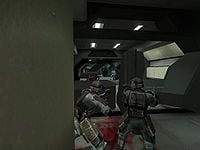Combat barrier: Difference between revisions
From Halopedia, the Halo wiki
(grammar) |
No edit summary |
||
| Line 1: | Line 1: | ||
{{Ratings}} | |||
{{Era|H1|H2|H3}} | {{Era|H1|H2|H3}} | ||
[[Image:Siege.jpg|right|thumb|A pair of UNSC Marines use Combat Barriers to defend against the Covenant boarding of the UNSC ''[[Pillar of Autumn]]''.]] | [[Image:Siege.jpg|right|thumb|A pair of UNSC Marines use Combat Barriers to defend against the Covenant boarding of the UNSC ''[[Pillar of Autumn]]''.]] | ||
A '''Combat Barrier''' is a mobile ground fortification barrier in use by the [[United Nations Space Command]]. | |||
The player can use barriers to shoot from behind, and then to duck as an opponent fires on them. Combat barriers can be found in a few levels in [[Halo: Combat Evolved]], mainly on the ''[[Pillar of Autumn]]''. They can also be found in many levels in | Much like the Covenant [[Roadblock]]s of ''[[Halo 2]]'' they are placed around strategic sites as defensive mechanisms against enemy [[weapons]] fire. Several types of barriers exist, but all are made of thick battle plating presumably made of titanium or titanium-ceramic [[armor]]. The purpose of combat barriers is simple: to protect soldiers and dug-in fortifications from the enemy. While they are almost impenetrable to [[plasma]] and projectile weapons, they do not protect well against the concussive force of an explosion such as a rocket or grenade impact, but do well to absorb shrapnel and flying debris. | ||
The player can use barriers to shoot from behind, and then to duck as an opponent fires on them. Combat barriers can be found in a few levels in ''[[Halo: Combat Evolved]]'', mainly on the ''[[Pillar of Autumn]]''. They can also be found in many levels in ''Halo 2'', primarily on [[Cairo Station]] and [[Earth]]. They also exist in several [[multiplayer]] levels in each game, such as [[Longest]], [[Turf]] and [[Relic]]. | |||
They appear once again in ''[[Halo 3]]'' in the UNSC base [[Crow's Nest (Base)|Crows Nest]]. They are also one of the many objects in [[forge]] gameplay. | |||
[[Category:UNSC]] | [[Category:UNSC]] | ||
Revision as of 04:33, April 2, 2008

A Combat Barrier is a mobile ground fortification barrier in use by the United Nations Space Command.
Much like the Covenant Roadblocks of Halo 2 they are placed around strategic sites as defensive mechanisms against enemy weapons fire. Several types of barriers exist, but all are made of thick battle plating presumably made of titanium or titanium-ceramic armor. The purpose of combat barriers is simple: to protect soldiers and dug-in fortifications from the enemy. While they are almost impenetrable to plasma and projectile weapons, they do not protect well against the concussive force of an explosion such as a rocket or grenade impact, but do well to absorb shrapnel and flying debris.
The player can use barriers to shoot from behind, and then to duck as an opponent fires on them. Combat barriers can be found in a few levels in Halo: Combat Evolved, mainly on the Pillar of Autumn. They can also be found in many levels in Halo 2, primarily on Cairo Station and Earth. They also exist in several multiplayer levels in each game, such as Longest, Turf and Relic.
They appear once again in Halo 3 in the UNSC base Crows Nest. They are also one of the many objects in forge gameplay.